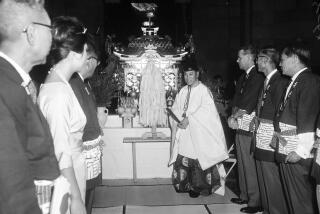Ship Relic Sending Out an SOS
- Share via
The Lane Victory hauled munitions in the South Pacific at the close of World War II. During the Korean War, it ferried troops and evacuated 7,000 civilians as the Communists advanced on Inchon.
When the Vietnam War started, the government summoned the aging transport out of the reserve fleet to serve the U.S. military for a third time.
Today, the last operational Victory ship, which has been restored by a group of retired merchant seamen in Los Angeles Harbor, is in a new battle. This time, its foes are its own bottom line and the Port of Los Angeles’ bureaucracy.
If it loses, the 455-foot vessel and national landmark could be sent back from where it came more than a decade ago--Suisun Bay near San Francisco, the mothball fleet, the Navy’s hospice for obsolete warships bound for the scrap yard.
With expenses now surpassing $200,000 a year and a limited budget, the nonprofit organization that owns the famous transport has gone hat in hand to the Port of Los Angeles seeking to reduce or eliminate its annual rent of nearly $54,000.
Other historic vessels on display around the state pay little or no rent, say members of the U.S. Merchant Marine Veterans of World War II, who have turned the Lane Victory into a floating memorial for their shipmates killed in battle.
“If anything goes wrong, we could be in trouble,” said Ernest E. Barker, 72, of Lomita, a former engineering officer and director of the organization. “A break in our rent could mean the difference between keeping the ship and going belly up.”
Under terms of its agreement with the federal government, the group is responsible for the Lane Victory’s maintenance, operation and repairs. If the organization can’t afford the upkeep, the vessel must be returned to the Navy’s ready reserve fleet.
“It would be a tremendous loss,” said Joseph B. Vernick, 85, of Seal Beach, a former prisoner of war and one of the group’s founders. “Millions of dollars have been spent and hundreds of people have worked to save that ship.”
With the help of Congress, the organization obtained the vessel in 1987 after a five-year search for a restorable military transport. In 1989, a Navy tug towed the ship from Suisun Bay to Los Angeles for free.
Since then, volunteers--many of them in their 60s, 70s and 80s-- have labored hundreds of thousands of hours to make the Lane Victory fully operational.
The ship is now a museum piece open to the public at Berth 94, next to the cruise terminal. Its passageways are filled with plaques engraved with the names of merchant seamen who lost their lives during wartime.
Since the Lane Victory’s arrival, the organization’s expenses have steadily escalated. The rent charged by the port has gone up from about $1,400 a month to almost $4,500 a month.
Repairs, maintenance and operation are costly, averaging more than $200,000 a year. The ship was just overhauled for more than $400,000--all of it paid in cash because the group has no credit.
To cover expenses, the organization relies on paid memberships, tours, gate receipts and six cruises to Catalina Island every year for the public.
The bulk of the Lane Victory’s revenue, however, comes from movies, commercials and television shows. It has been in such films as “Titanic,” “The Thin Red Line,” “The Port Chicago Mutiny” and “Naked Gun 2 1/2.”
Officials for the group say that the production work, while lucrative, can be sporadic. If there is a dry spell in which a major repair has to be made, they say, it might be disastrous for the organization.
Barker said the group asked the port to reduce or waive the ship’s rent because it is the only flexible area of the budget. Discussions are getting underway.
“We have always had a good relationship with the Lane Victory, and we realize the importance of what they bring to the harbor and community,” said Barbara Yamamoto, the port’s public information director. “We will sit down and discuss what their options might be.”
Yamamoto said the port has provided substantial improvements to the Lane Victory’s berth, including gangway upgrades and a concrete wharf.
The organization contends that the vessel is a magnet for tourists and a substantial asset to the city. It has been used for education, emergency preparedness, public relations for the port, and training by police and fire departments.
“We aren’t looking for any handout,” Barker said. “Just what we think we have earned over the last 10 years.”
Just as significant, the veterans group contends that other historic ships on display in the state’s major ports pay token rents or none at all.
In San Francisco, the S.S. Jeremiah O’Brien, one of the last existing Liberty ships, pays the port $1,000 in rent a month, plus 6% of its gate receipts above $1,000. Liberty ships are military transports that preceded Victory ships. They were mass-produced during the first years of World War II.
On display in San Diego are the bark Star of India, the oldest actively sailed square-rigged ship in the world; the Berkeley, a 100-year-old San Francisco Bay ferry; and the steam-powered yacht Medea, built in 1904.
San Diego officials say that the operators of those vessels pay no rent because they are an asset to tourism and maritime history. The city also has donated $40,000 to the Star of India.
“If you look at their financial situations and ours,” said John Clayton, a spokesman for the Lane Victory, “its like looking at a mouse and an elephant.”



